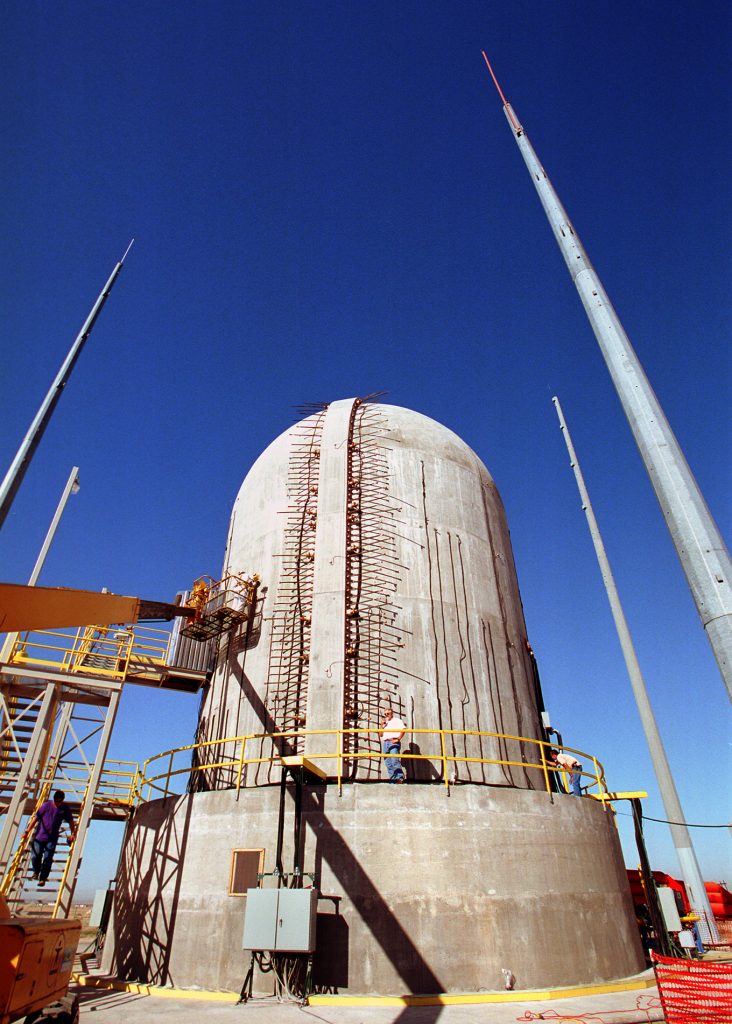
Download 300dpi JPEG image, ‘Containment.jpg’, 1.9MB (Media are welcome to download/publish this image with related news stories.)
ALBUQUERQUE, N.M. — Next week researchers at the Department of Energy’s Sandia National Laboratories will “test to failure” a structure that took three years to build.
On Tuesday, Sept. 26, Sandia test engineers will begin pumping nitrogen gas into a 1/4-scale concrete model of a nuclear power plant containment vessel, gradually increasing the gas pressure until the structure fails. The 70-ft.-tall, 35-ft.-diameter domed cylinder is a small-scale replica of a pre-stressed concrete containment vessel (PCCV) at an operating nuclear power plant in Japan.
The test is sponsored by the U.S. Nuclear Regulatory Commission (NRC) and Japan’s Nuclear Power Engineering Corporation (NUPEC).
In a PCCV, the structure’s carefully constructed internal network of steel “tendons” gently squeezes the concrete to create an inward pressure that in a reactor accident would offset some outward pressure created by a steam release, thereby keeping the steam and any nuclear hazards inside the vessel. Full-scale PCCVs at nuclear power plants are expected to withstand pressures several times beyond what an accident is likely to produce.
The PCCV model was built with nearly 1,500 sensors and fiber optic lines embedded into its materials so the researchers could gather tens of thousands of lines of data about its performance before and during the test. It is the largest nuclear reactor containment vessel model ever tested to failure.
A primary goal of the test is to validate the computer codes the NRC uses to predict how much pressure full-scale PCCVs could tolerate in severe nuclear power plant accidents. Another goal is to demonstrate that existing PCCVs at power plants in Japan and the U.S. would perform their safety functions reliably in an accident.
In December 1996, Sandia tested to failure a 1/10-scale model of a nuclear power reactor steel containment vessel for the NRC and NUPEC.
| Results of the test (updated Oct. 1, 2000): Sandia National Laboratories test engineers began pumping nitrogen gas into the 1/4-scale model of a pre-stressed concrete containment vessel (PCCV) at 10 am Tuesday, Sept. 26, increasing the internal gas pressure gradually. At about noon on Wednesday, Sept. 27, as the internal pressure inside the model was approaching 2.5 times the model’s design pressure, test engineers detected and verified a leak in the vessel. They increased the gas pressure at a faster rate until about 5 pm, at which time the model was losing pressure faster than the researchers could pump gas in. The maximum internal pressure at that time was about 3.1 times the model’s design pressure. The test was terminated at about 6 pm, Wednesday, Sept. 27. Engineers have not yet determined exactly where the structure failed. Results of the test will be made available to the international nuclear safety community after they have been reviewed by Sandia, NUPEC, and the US NRC. |